Learning Technologies Group Bundle
Can Learning Technologies Group Continue Its Impressive Growth Trajectory?
Learning Technologies Group (LTG) has become a powerhouse in the EdTech sector, but how does it plan to maintain its momentum? The company's strategic acquisitions, like that of GP Strategies, have reshaped the corporate training landscape. This deep dive explores the Learning Technologies Group SWOT Analysis to understand its growth strategy and future prospects.
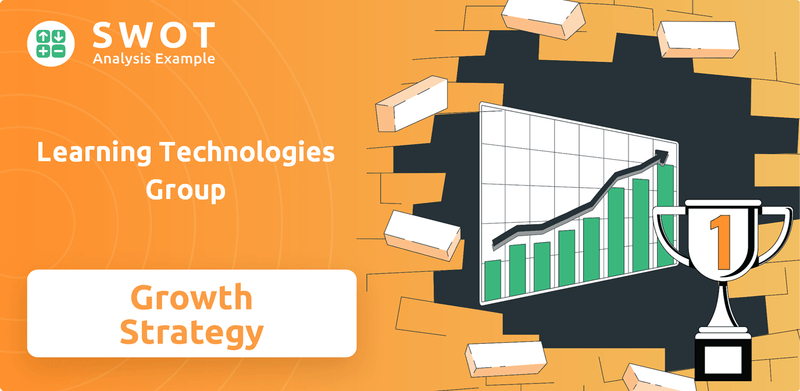
From its inception in 2007, the LTG company has consistently demonstrated a commitment to innovation and strategic expansion. Today, LTG serves millions globally, and its influence continues to grow. This analysis will examine the key drivers behind LTG's success, including its approach to digital transformation and its long-term goals within the evolving market of corporate learning.
How Is Learning Technologies Group Expanding Its Reach?
The expansion initiatives of Learning Technologies Group (LTG) are designed to drive sustained growth and solidify its position in the EdTech market. These initiatives are multifaceted, encompassing geographical expansion, product development, strategic partnerships, and a focus on recurring revenue models. The company's approach aims to not only increase its market share but also to diversify its revenue streams and enhance its service offerings to meet the evolving needs of its clients.
A core component of LTG's growth strategy involves expanding its geographical footprint, particularly in high-growth regions. Simultaneously, the company is focused on deepening its presence in existing markets through cross-selling and upselling its comprehensive suite of products and services. This dual approach allows LTG to leverage its existing customer base while tapping into new opportunities for growth. The acquisition of GP Strategies was a strategic move to strengthen its presence, especially in North America, and to expand its consulting capabilities.
Product pipeline expansion is another critical area of focus for LTG. The company consistently invests in the development of new learning platforms, content creation tools, and talent management solutions. For example, platforms like LEO Learning, gomo, and PeopleFluent are frequently updated to incorporate the latest pedagogical approaches and technological advancements. This commitment to innovation ensures that LTG remains at the forefront of the industry, offering cutting-edge solutions to its clients. The Marketing Strategy of Learning Technologies Group provides further insights into the company's approach.
LTG is actively expanding its presence in high-growth regions, such as Asia-Pacific, to tap into new markets. This includes establishing local offices and partnerships to better serve regional clients. The company aims to increase its international revenue to 35% of total revenue by 2026.
LTG invests heavily in R&D to develop new learning platforms and tools. This includes integrating AI and machine learning to enhance personalization and improve learning outcomes. The company plans to launch three new product lines by the end of 2025.
LTG is forming strategic partnerships with technology providers and consulting firms to expand its reach. These collaborations aim to offer integrated solutions and access new customer segments, such as SMEs. The company targets 10 new strategic partnerships by the end of 2024.
LTG focuses on Software-as-a-Service (SaaS) offerings to build a consistent revenue stream. This model provides predictable revenue and supports long-term growth. SaaS revenue is expected to account for over 70% of total revenue by 2026.
LTG's expansion strategies are designed to capitalize on the growing demand for digital learning solutions. These strategies include geographical expansion, product innovation, and strategic partnerships.
- Geographical Expansion: Targeting high-growth regions and expanding in existing markets.
- Product Innovation: Developing new learning platforms and integrating AI.
- Strategic Partnerships: Collaborating with technology providers and consulting firms.
- Recurring Revenue: Focusing on SaaS offerings for stable revenue streams.
Learning Technologies Group SWOT Analysis
- Complete SWOT Breakdown
- Fully Customizable
- Editable in Excel & Word
- Professional Formatting
- Investor-Ready Format
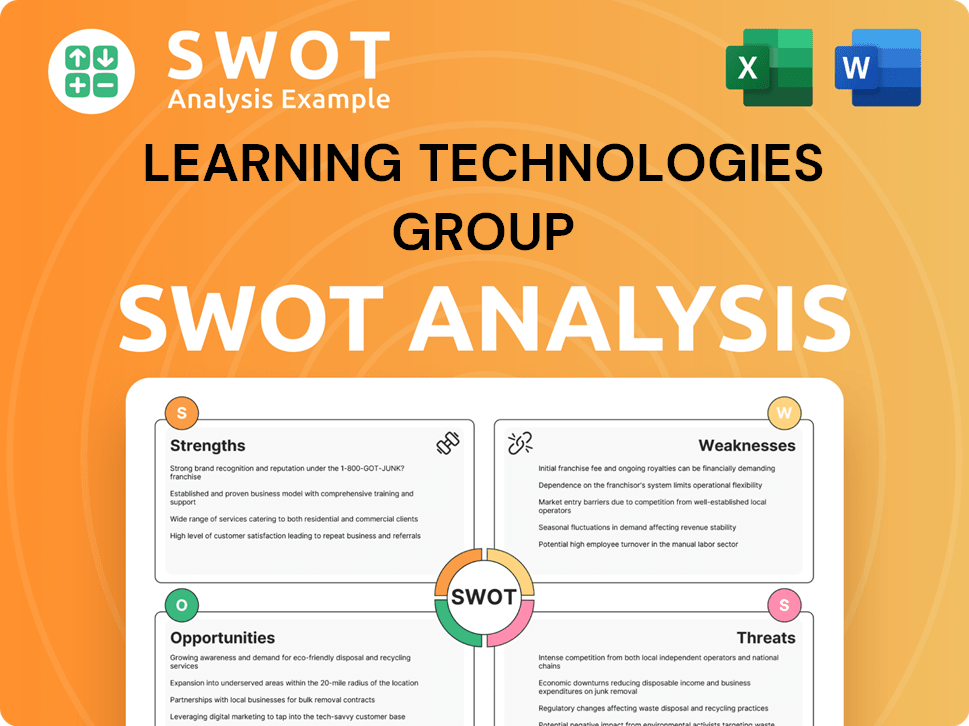
How Does Learning Technologies Group Invest in Innovation?
The sustained growth of Learning Technologies Group (LTG) is significantly influenced by its innovation and technology strategy. The company's dedication to research and development (R&D), both internally and through collaborations, is a cornerstone of its approach. This focus ensures that LTG remains at the forefront of the EdTech sector, constantly improving its existing platforms and developing new solutions.
A key aspect of LTG's strategy involves digital transformation, utilizing automation and data analytics to enhance learning experiences and talent management processes. LTG actively integrates cutting-edge technologies such as Artificial Intelligence (AI) and Machine Learning (ML) into its products. This integration helps personalize learning paths, provide intelligent content recommendations, and automate administrative tasks.
LTG also explores the potential of Virtual Reality (VR) and Augmented Reality (AR) for immersive learning experiences, especially in fields requiring hands-on training. New platforms and technical capabilities, such as advanced analytics dashboards and improved mobile learning functionalities, directly support growth objectives. These improvements offer greater value to clients and open up new market opportunities. For an overview of the company's revenue streams and business model, you can refer to Revenue Streams & Business Model of Learning Technologies Group.
LTG consistently invests in R&D to stay ahead in the Learning Technologies Group market. These investments fuel the development of innovative solutions and enhance existing products.
Digital transformation is a core element of LTG's strategy, leveraging automation and data analytics. This transformation optimizes learning experiences and talent management processes.
LTG actively incorporates AI and ML into its products to personalize learning. These technologies provide intelligent content recommendations and automate tasks.
The company explores VR and AR for immersive learning, particularly in fields requiring practical training. This enhances the learning experience through interactive simulations.
LTG regularly releases updated product versions to provide clients with the latest features and improvements. This commitment ensures that its offerings remain competitive and relevant.
LTG actively participates in industry thought leadership, demonstrating its commitment to shaping the future of learning technology. This helps establish LTG as a key player in the EdTech space.
The integration of AI and ML allows for personalized learning paths and automated administrative tasks. VR and AR offer immersive training, especially in fields like healthcare and engineering. Advanced analytics dashboards provide clients with better insights into learning outcomes.
- AI-Powered Personalization: AI algorithms tailor learning paths to individual needs, improving engagement and knowledge retention.
- Immersive VR/AR Training: VR and AR simulations provide realistic, hands-on training experiences, enhancing skill development.
- Data Analytics Dashboards: These dashboards offer detailed insights into learner progress and program effectiveness, helping clients optimize their training programs.
- Mobile Learning: Enhanced mobile functionalities allow learners to access content anytime, anywhere, increasing flexibility and convenience.
Learning Technologies Group PESTLE Analysis
- Covers All 6 PESTLE Categories
- No Research Needed – Save Hours of Work
- Built by Experts, Trusted by Consultants
- Instant Download, Ready to Use
- 100% Editable, Fully Customizable
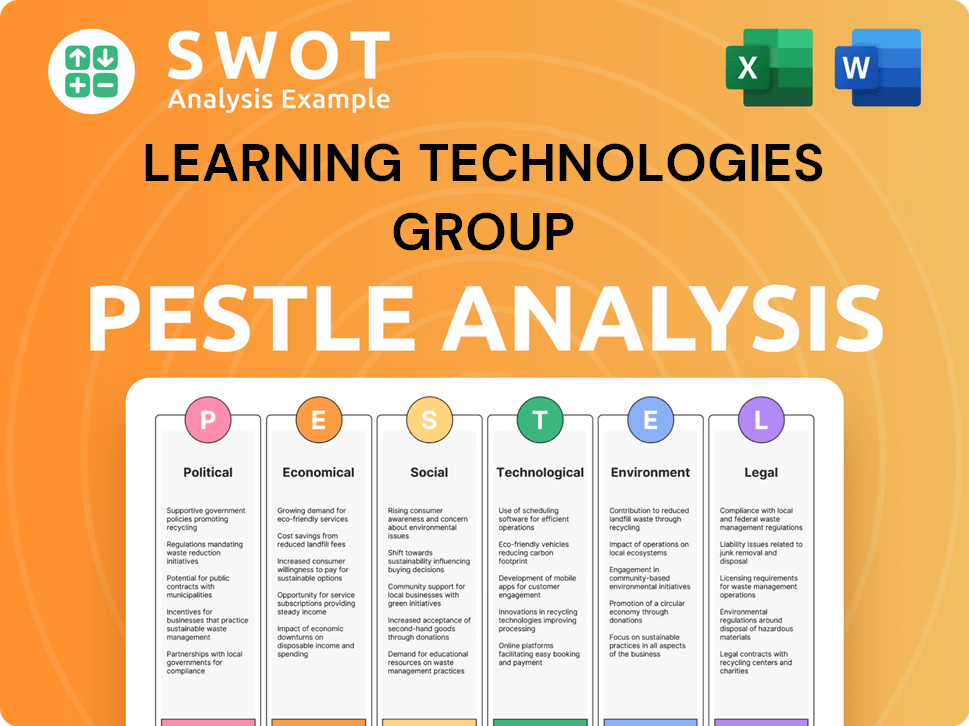
What Is Learning Technologies Group’s Growth Forecast?
The financial outlook for the company, also known as LTG, is shaped by its robust Growth strategy. The company is focused on increasing revenue and maintaining healthy profit margins. This strategic approach is supported by a strong foundation of recurring revenue, primarily from its Software as a Service (SaaS) offerings, which provides a stable financial base.
For the fiscal year ending December 31, 2024, the company projected revenues between £570 million and £585 million. Adjusted EBIT was anticipated to be in the range of £110 million to £120 million. These projections reflect the company's confidence in its ability to capitalize on the growing demand for digital learning solutions within the EdTech sector.
The company's financial strategy emphasizes operational efficiency and strategic investments. This approach is designed to fuel future expansion. The company's long-term financial objectives include expanding its global market share and achieving sustainable profitability through both organic growth and strategic acquisitions. The company's disciplined approach to capital allocation and its ability to integrate acquired businesses effectively contribute to its positive financial narrative, supporting its strategic plans for sustained growth.
The company's financial performance is closely tied to its ability to grow revenue. Analysts project steady revenue increases, driven by the rising demand for digital learning solutions. This growth is supported by the company’s strategic investments and acquisitions within the Corporate training market.
Maintaining healthy profit margins is a key financial goal for the company. The company’s focus on operational efficiency and strategic investments contributes to its profitability. The projected adjusted EBIT for 2024, between £110 million and £120 million, highlights the company's commitment to financial health.
A significant portion of the company's revenue comes from recurring sources, particularly its SaaS offerings. This recurring revenue base provides financial stability. This stability allows for more predictable financial planning and investment in Future prospects.
Acquisitions play a crucial role in the company's growth strategy. The company has a history of successfully integrating acquired businesses. The company’s ability to integrate acquired businesses contributes to its positive financial narrative and supports its sustained growth plans.
The company's financial performance is evaluated using several key metrics.
- Revenue Growth: The company aims for consistent revenue increases, driven by demand in the digital learning market.
- Profitability: Maintaining healthy profit margins is a key focus, supported by operational efficiency.
- Recurring Revenue: A significant portion of revenue comes from SaaS offerings, providing financial stability.
- Strategic Acquisitions: Acquisitions are a key component of the growth strategy, with a focus on effective integration.
The company's financial outlook is further influenced by its market presence and competitive positioning. For more insights into the markets the company targets, consider reading about the Target Market of Learning Technologies Group.
Learning Technologies Group Business Model Canvas
- Complete 9-Block Business Model Canvas
- Effortlessly Communicate Your Business Strategy
- Investor-Ready BMC Format
- 100% Editable and Customizable
- Clear and Structured Layout
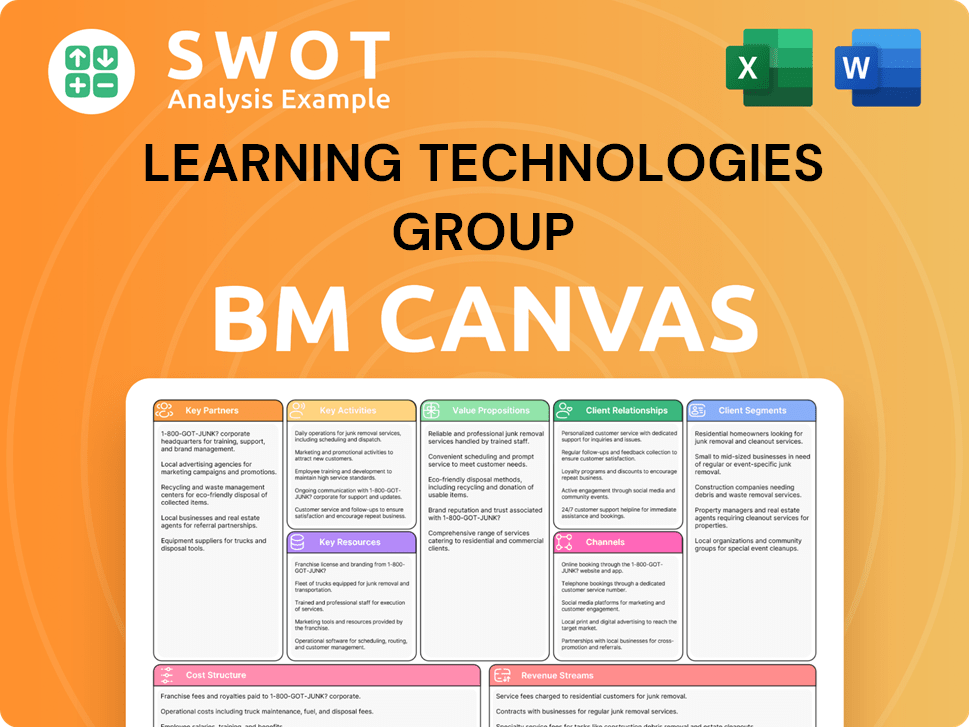
What Risks Could Slow Learning Technologies Group’s Growth?
The LTG company, while demonstrating a strong growth trajectory, faces several potential risks and obstacles that could impact its ambitions within the EdTech sector. These challenges range from intense market competition to the rapid pace of technological change. Effectively navigating these hurdles is crucial for sustaining its growth strategy and achieving its future prospects.
One of the primary risks is the competitive landscape, which includes both established players and emerging startups. Regulatory changes, especially concerning data privacy and security, also pose significant challenges. Furthermore, the need for continuous innovation and the ability to attract and retain top talent are crucial for long-term success in the corporate training market.
The company's ability to manage these risks is vital for its continued success. The company must proactively address these challenges through strategic planning and robust risk management. For a deeper dive into the company's origins and evolution, consider reading Brief History of Learning Technologies Group.
The digital learning and talent management space is crowded with competitors. The competition includes niche startups and large technology conglomerates, which increases the pressure on LTG company to maintain its market share and competitive advantage.
Changes in regulations, particularly those concerning data privacy and security, can create compliance challenges. These changes require operational adjustments and investment to ensure adherence to new standards, such as GDPR and CCPA, impacting the company's operational costs.
The fast-paced nature of technological advancements poses a constant threat. LTG company must continually innovate to avoid becoming obsolete and maintain its edge against emerging technologies and new business models. This includes adapting to AI and other advanced technologies.
Attracting and retaining top talent in a competitive labor market is essential. Internal resource constraints, such as the ability to secure skilled professionals, could hinder the company's ability to execute its growth strategy. This is particularly true in the tech sector, where demand is high.
Although less prominent in a software-centric business, supply chain issues can arise. Reliance on specific technology partners or infrastructure providers could lead to vulnerabilities. Diversifying partnerships and ensuring supply chain resilience are key strategies.
Economic downturns can affect corporate spending on corporate training and development. A decrease in demand for services could impact revenue. The company needs to be prepared for economic fluctuations and adjust its strategies accordingly.
LTG company addresses these risks through a diversified portfolio of products and services, which reduces dependency on any single offering. Robust risk management frameworks are in place to identify and mitigate potential issues. The company also uses proactive scenario planning to anticipate and prepare for various challenges.
While specific recent examples of overcoming major obstacles are not always publicly detailed, LTG company's consistent growth and successful integration of numerous acquisitions demonstrate its ability to navigate complex business environments. This includes adapting to market changes and integrating new technologies.
Learning Technologies Group Porter's Five Forces Analysis
- Covers All 5 Competitive Forces in Detail
- Structured for Consultants, Students, and Founders
- 100% Editable in Microsoft Word & Excel
- Instant Digital Download – Use Immediately
- Compatible with Mac & PC – Fully Unlocked
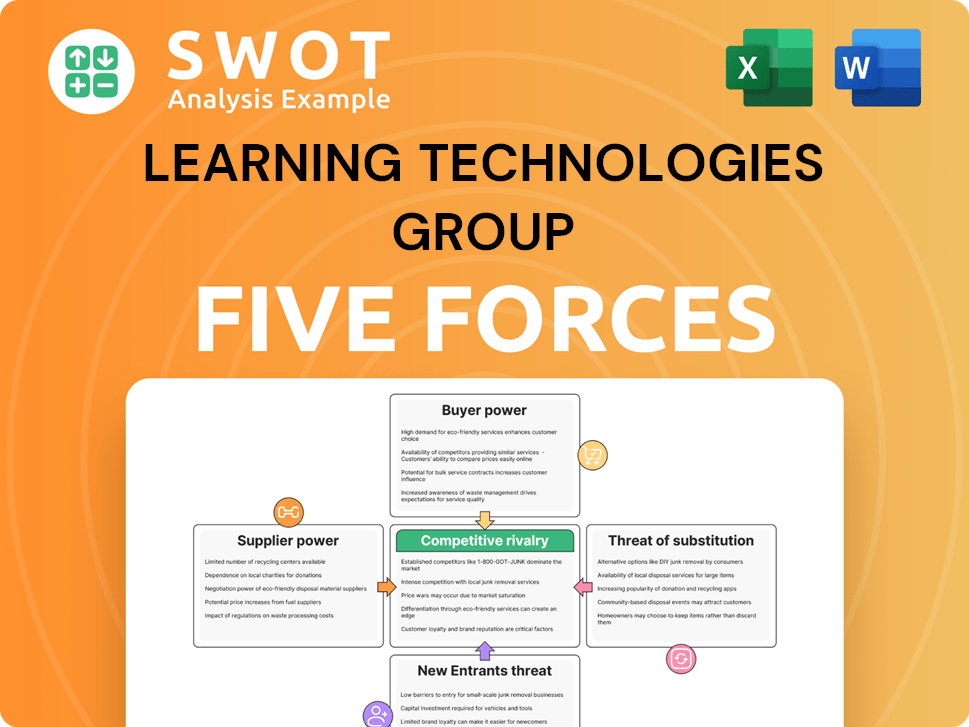
Related Blogs
- What are Mission Vision & Core Values of Learning Technologies Group Company?
- What is Competitive Landscape of Learning Technologies Group Company?
- How Does Learning Technologies Group Company Work?
- What is Sales and Marketing Strategy of Learning Technologies Group Company?
- What is Brief History of Learning Technologies Group Company?
- Who Owns Learning Technologies Group Company?
- What is Customer Demographics and Target Market of Learning Technologies Group Company?
Disclaimer
All information, articles, and product details provided on this website are for general informational and educational purposes only. We do not claim any ownership over, nor do we intend to infringe upon, any trademarks, copyrights, logos, brand names, or other intellectual property mentioned or depicted on this site. Such intellectual property remains the property of its respective owners, and any references here are made solely for identification or informational purposes, without implying any affiliation, endorsement, or partnership.
We make no representations or warranties, express or implied, regarding the accuracy, completeness, or suitability of any content or products presented. Nothing on this website should be construed as legal, tax, investment, financial, medical, or other professional advice. In addition, no part of this site—including articles or product references—constitutes a solicitation, recommendation, endorsement, advertisement, or offer to buy or sell any securities, franchises, or other financial instruments, particularly in jurisdictions where such activity would be unlawful.
All content is of a general nature and may not address the specific circumstances of any individual or entity. It is not a substitute for professional advice or services. Any actions you take based on the information provided here are strictly at your own risk. You accept full responsibility for any decisions or outcomes arising from your use of this website and agree to release us from any liability in connection with your use of, or reliance upon, the content or products found herein.